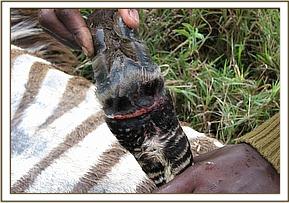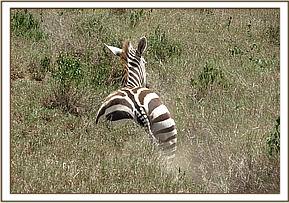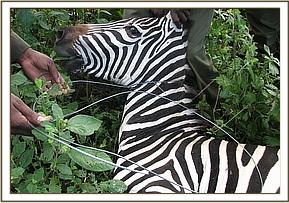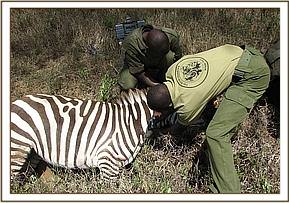Introduction During the month of May there was so much work in denaring or treating animals of various injuries
Introduction
During the month of May there was so much work in denaring or treating animals of various injuries. Cases of animal mortalities in different areas especially in Naivasha were reported for veterinary attention. It has been a rainy season and there is enough pasture and water for wild animals. Most of the animals are therefore in good body condition and the population is expected to increase despite the rise in number of cases of snare or animal injuries due to human-wildlife conflicts. Apart from being involved in animal rescues and clinical cases, the veterinary team also took part in Wildlife censures that was conducted recently in Naivasha area.
Desnaring of a Common zebra in Kongoni farm
This was a case of a female zebra that had a loose wire dangling on its neck, the wire had not inflicted any injury to the neck but the animal was seemingly disturbed and restless so we decided to relieve it. It got immobilized through darting using 5mgs of etorphine hydrochloride combined with 60mgs of xylazine. The animal went down after 7minutes.
The wire was immediately cut off using a wire cutter and the animal revived from anaesthesia. It had a foal and they rejoined immediately afterwards.
Treatment of an injured Common zebra in Kongoni farm
After desnaring we came across a limping zebra in the same area, it was an adult female
Zebra probably with a sprain. It was also chemically immobilized and the limb examined closely. The animal had a dislocation on the tarsal joint of the right hind limb; this was undergoing the healing process. It was treated with long acting antibiotics and dexamethasone administered intramuscularly then revived from anaesthesia.
Treatment of a wounded Common zebra in KARI farm
This was a female juvenile zebra that had a snare wound on its left hind limb. One of these was a juvenile female zebra that was not able to keep pace with others and we decided to attend to it. The animal was physically restrained using a rope since it was too young and unable to move fast.
On examination, the left hind limb had a septic wound that seemed to have been caused by a wire snare after it escaped.


Desnaring of a common zebra in Mundui farm.
This particular zebra was found with a wire snare around the neck and we decided to rescue it. The wire was removed after it was captured by chemical immobilization by darting from a vehicle. Then the animal was revived and released back to the wild.
Desnaring of a male common zebra in Crater Lake farm.
This animal was reported by the management of Crater Lake sanctuary that it had a plain wire dangling around the neck, the veterinary team responded in time and the zebra was found in a company of others. It was then immobilized and the wire removed using a wire cutter. The anaesthesia was revived and the animal released successfully .

Treatment of two wounded common zebras in KARI farm.
In KARI farm we came across two zebras that had snare wounds on the limbs and had difficulties in walking. One of these zebras was euthanized as it had no chances of recovery due to fractured tarsal bones. The other zebra was treated and released. The carcass was then disposed of by burying.
Euthanasia of two common zebras in KARI farm
Treatment of a common zebra caught up with a plastic cup in Aquilla farm, Naivasha.
We encountered this animal in Aquilla farm while patrolling the area, it was a female adult zebra that had a white plastic cup on the left hind limb at the tarsal joint. It had not inflicted any injuries but the animal was not comfortable walking with it. The animal was immobilized and the plastic removed then revived from anaesthesia
Postmortem examination of a female waterbuck in Sopa lodges in Naivasha.
The management of the hotel reported to the veterinary team through the Warden Naivasha that there was a dead waterbuck in their compound and they requested for a postmortem examination to be done to know the cause of death and the carcass be disposed appropriately. We then moved there and carried out a postmortem examination on the caracass. It was in a good body condition and it seemed to have died of an acute condition.
Some of the significant findings included hepatomegally, cardiomegally, blood tinged peritoneal fluid. There was also marked congestion and haemorrhages of various organs such as the lungs, liver and heart. The tentative diagnosis was an Acute Haemorrhagic septiceamia caused by Pasteurella a bacterial condition that can set in when an animal is under stressful conditions.
Clinical assessment of Impalas in Nderit farm:
It was reported to the veterinary team that 5 impalas and 1 Thompson’s gazelle died in Nderit farm and other animals in these herds were weak and debilitated. Unfortunately all the carcasses of the dead animals were consumed by hyenas before the veterinary team reported so we could not get any carcass to examine
We came across a female impala that was in a group of about 10 impalas, it was severely emaciated, allopecic and weak, and we then decided to immobilize it to examine and obtain samples that could help us determine the cause of the reported mortalities. The Impala was immobilized by darting using 3mgs of etorphine hydrochloride combined with 10mgs of xylazine hydrochloride. It took about 5 minutes for the animal to become fully immobilized.
On close observation the animal had worn out teeth that could be attributed to either old age or mineral deficiencies. We decided to euthanize the animal and do open postmortem examination to ascertain the cause of the problem. When we opened the carcass, there was marked lung hepatization and cardiomegally which suggested that the animal was suffering from a chronic pneumonia and was unable to feed adequately due to loss of teeth hence loss of body condition. Serum and tissue samples were then collected for further laboratory analysis. The carcass was then disposed of by deep burying.
Two common zebras euthanized in KARI farm Naivasha:
These zebras were found in a large group of zebras and they were basically unable to move due to pain and irritation of the injured limbs. In both of them, the hooves were completely cut off probably by snares. We decided to immobilize each of them at a time asses the extent of injury and euthanize where applicable.


Conclusion
During the month of May, there were so many cases of snaring of wildlife in Naivasha area despite the fact that there was a lot of rains in that area and the animals had enough pastures. There were also cases of disease infections and cases of animal mortalities reported from Nderit farm, Delamere ranch (Soysambu farm), and within Lake Nakuru National Park. Plans are underway to carry out a proper investigation and surveillance to confirm the etiology. There were no cases reported from other parts of Central Rift Region and therefore a lot of veterinary intervention work was concentrated in Naivasha area.